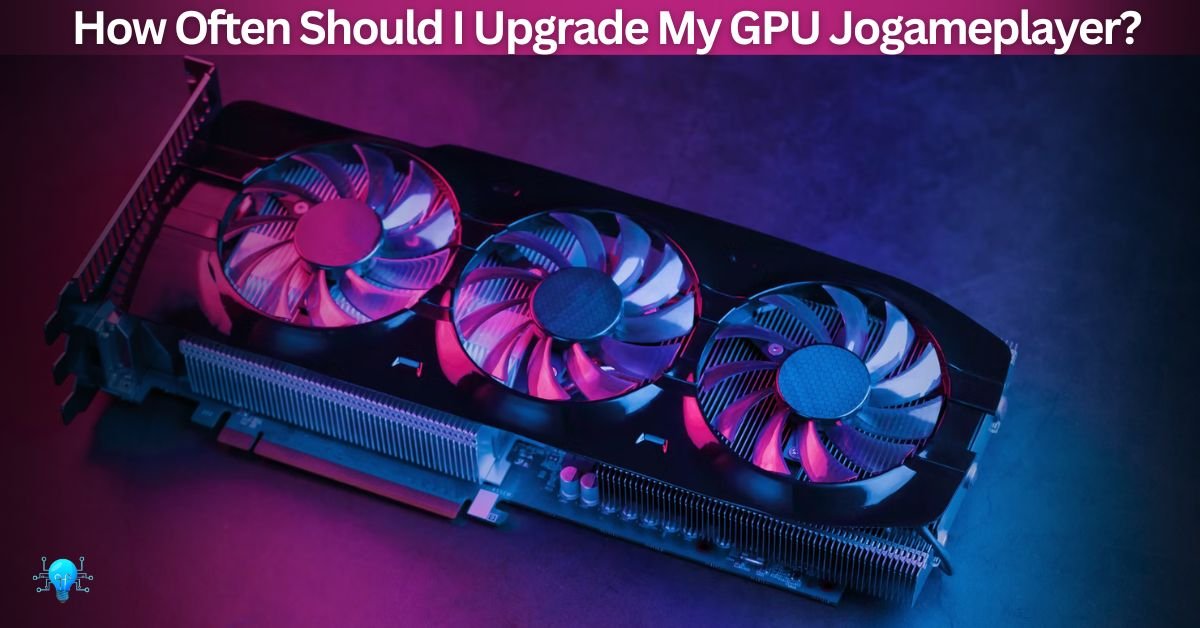Upgrading your GPU is a crucial aspect of maintaining an optimal gaming experience.
You should consider upgrading your GPU jogameplayer every 2-3 years to keep up with advancing technology and demanding game requirements. If you notice performance issues or your GPU can’t handle new games effectively, it’s time for an upgrade.
Understanding how often you should upgrade your GPU jogameplayer involves various factors, including technological advancements, game requirements, and personal preferences. Let me tell you in detail this procedure.
Why is Upgrading the GPU Important? – You Should Know This First!
Upgrading your GPU is important because it directly affects the performance and visual quality of games. Modern games demand higher graphical power to run smoothly, and an outdated GPU can lead to lag, lower frame rates, and subpar graphics.
So, By upgrading your GPU jogameplayer, you can ensure that you are getting the best possible gaming experience, with faster processing speeds and enhanced visual effects.
When One Should Update Their GPUs?
Determining when to update your GPU depends on several factors. Generally, you should consider upgrading every 2-3 years. However, if you notice that your current GPU struggles with new game releases, it may be time for an upgrade sooner. Additionally, if your GPU is no longer supported by manufacturers or cannot run the latest games at acceptable settings, it is a clear sign to invest in a new one. Read this detailed conversation of the people having a discussion over Reddit!
How to Upgrade the GPU Jogameplayer?
Upgrading your GPU jogameplayer involves several steps. Follow this guide to ensure a smooth upgrade process.
Step 1: Ensure Power Supply Compatibility
Before purchasing a new GPU, check if your power supply unit (PSU) can support the new GPU’s power requirements. Most modern GPUs need a PSU with a specific wattage and the correct power connectors.
Step 2: Check Motherboard Compatibility
Verify that your new GPU is compatible with your motherboard. Most GPUs use the PCIe (Peripheral Component Interconnect Express) slot. Ensure your motherboard has an available PCIe slot and that the GPU’s dimensions fit within your case.
Step 3: Remove the Old GPU
Power down your computer and unplug it. Open your computer case and locate the current GPU. Unscrew it from the PCIe bracket and gently pull it out of the PCIe slot.
Step 4: Install the New GPU
Align the new GPU with the PCIe slot and gently press it in until it clicks into place. Secure the GPU with screws to the PCIe bracket to ensure it stays firmly in position.
Step 5: Connect Power Cables
Modern GPUs often require additional power connectors. Connect the necessary power cables from your PSU to the new GPU. Ensure the connections are secure to provide sufficient power to the GPU.
Step 6: Boot Up and Install Drivers
Close your computer case, plug it back in, and power it on. Once the system boots up, download and install the latest drivers for your new GPU from the manufacturer’s website. This ensures that your GPU operates at peak performance and is compatible with your games and applications.
Step 7: Test the New GPU
After installing the drivers, test the new GPU with a few games or benchmarking tools to ensure it’s functioning correctly. Monitor the temperatures and performance to confirm the upgrade was successful.
What is GPU Jogameplayer? – In Case You’re Infamiliar!
GPU jogameplayer refers to the graphical processing unit designed to enhance gaming performance. It processes complex graphical computations, rendering high-quality images and videos for a seamless gaming experience. A powerful GPU jogameplayer can handle demanding games, providing smooth gameplay, detailed textures, and realistic lighting effects.
Do You Know? Is 80 Degrees Celsius Hot For A GPU? Attention, All gamers!
Are There Some Cautions to Consider While Upgrading the GPU?
When upgrading your GPU jogameplayer, it’s important to take several precautions to ensure a successful installation and to avoid damaging your system:
Compatibility Check: Ensure that the new GPU is compatible with your motherboard. Verify that it fits into the available PCIe slot and that your case has enough space to accommodate its size.
Power Supply: Confirm that your power supply unit (PSU) can handle the power requirements of the new GPU. Check the wattage and ensure that the PSU has the necessary power connectors for the GPU.
Physical Dimensions: Measure the physical dimensions of the GPU and compare them with the available space in your case. Make sure there is enough room for airflow around the GPU to prevent overheating.
Static Discharge: Before handling the GPU or any internal components, ground yourself to prevent static discharge. Use an anti-static wrist strap or frequently touch a grounded metal object to discharge any static electricity.
Driver Updates: Uninstall the old GPU drivers before installing the new GPU. Once the new GPU is installed, download and install the latest drivers from the manufacturer’s website to ensure optimal performance.
Temperature Monitoring: After installation, monitor the GPU’s temperature during use. Ensure that your cooling system is adequate to prevent overheating, which can damage the GPU and other components.
Secure Connections: Double-check all connections, including power cables and the seating of the GPU in the PCIe slot. Loose connections can lead to performance issues or hardware failure.
By keeping these cautions in mind, you can safely and effectively upgrade your GPU jogameplayer, ensuring improved performance and longevity for your gaming system.
Pros and Cons of Upgrading GPU Jogameplayer
Pros:
Enhanced Performance: Upgrading your GPU jogameplayer can significantly boost your system’s performance, allowing you to play games at higher settings and resolutions.
Future-Proofing: A new GPU can keep your system relevant for future game releases, reducing the need for frequent upgrades.
Better Visuals: Experience improved graphics quality, with higher frame rates and better rendering of textures and effects.
Cons
Cost: Upgrading to a high-end GPU can be expensive, and not everyone may have the budget for frequent upgrades.
Compatibility Issues: Some older systems may face compatibility issues with newer GPUs, requiring additional upgrades to other components.
Power Consumption: New GPUs often consume more power, necessitating a more robust PSU, which can add to the overall cost.
Some FAQs:
How often should I upgrade my GPU jogameplayer?
You should consider upgrading your GPU every 2-3 years or when you notice performance issues with new games.
What factors should I consider before upgrading my GPU jogameplayer?
Consider compatibility with your system, power supply requirements, and the physical size of the new GPU.
Is upgrading the GPU jogameplayer difficult?
Upgrading a GPU is relatively straightforward, but ensure you follow proper procedures to avoid damaging components.
Can I use my old GPU alongside the new one?
While it’s technically possible to use multiple GPUs in a system (a setup known as SLI or Crossfire), it’s generally not necessary for most users. Most modern games and applications don’t require multi-GPU setups, and using an old GPU alongside a new one can lead to compatibility issues and increased power consumption.
How do I know if my new GPU is performing as expected?
To ensure your new GPU is performing well, use benchmarking tools like 3DMark or Unigine Heaven. These tools can help you measure the performance and compare it with the expected results. Additionally, monitor the GPU’s temperature and performance using software like MSI Afterburner or GPU-Z.
What should I do if my new GPU isn’t recognized by my system?
If your new GPU isn’t recognized, first check that it’s properly seated in the PCIe slot and that all power connectors are securely attached. If it’s still not recognized, try updating your motherboard’s BIOS or resetting it to default settings. Also, ensure that your GPU drivers are properly installed.
Can upgrading my GPU affect my system’s overall stability?
Upgrading your GPU can affect system stability if the new GPU is not compatible with your existing hardware or if the power supply is inadequate. To maintain system stability, ensure all components are compatible, and check that your PSU meets the power requirements of the new GPU.
How do I choose the right GPU for my needs?
When selecting a GPU, consider your specific needs, such as the types of games you play, desired resolution, and graphics settings. Research and compare different models based on their performance benchmarks, memory capacity, and features to find the best GPU for your requirements and budget.
To Sum Up:
Upgrading your GPU jogameplayer is essential for maintaining a high-quality gaming experience.
Assess Performance Needs > Check for Compatibility Issues > Evaluate Game Requirements > Consider Technological Advancements > Review Manufacturer Support >
Monitor System and GPU Health > Plan for Budget and Cost > Upgrade Every 2-3 Years.
So, Whether you’re a casual gamer or a hardcore enthusiast, staying updated with the latest GPU technology ensures you get the best performance and visual fidelity in your games.

